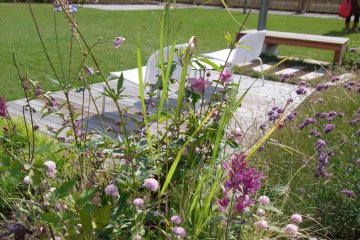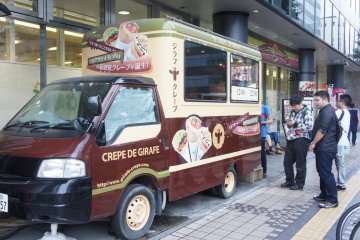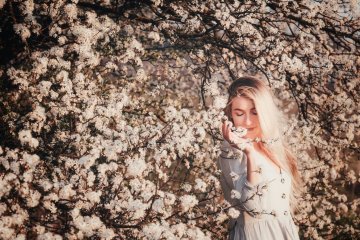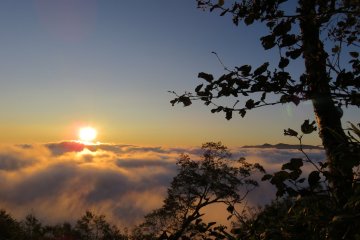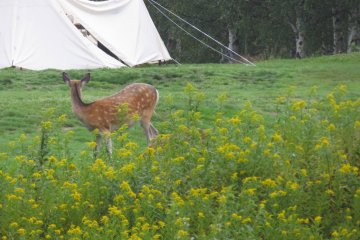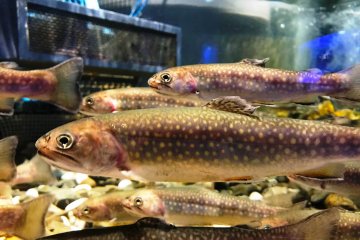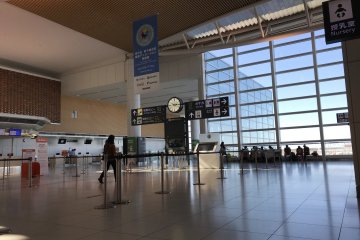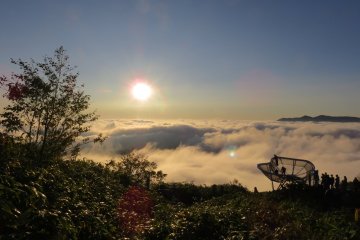May marks Hokkaido’s transformation, from the long dark days of Winter to the beginning of Spring. It may be the last place touched by the wave of cherry blossoms, moving from south to north, but the people here look forward to celebrating it even more than those in Nara or Tokyo. This is truely, the best time to travel to Hokkaido, Japan's northern island.
Also known as Sakura, Cherry blossoms are symbols of new life, a new beginning. It is the Sakura that keeps people going during the long dark winters, and with the sunrise being at 7 am and sunset at 4 pm in December, you may never see sunlight if you are inside an office all day. On average Sapporo receives 191 inches of snow a year, which is nearly 5 meters of snow that the locals need to shovel out of their doorways.
A long time ago, the aristocrats in Nara celebrated Spring by admiring plum blossoms, which bloom earlier than cherry blossoms. Today in Hokkaido, you can taste, see and feel the coming of spring, from the plum wine festival in April, followed by a picnic under the cherry blossoms, or dancing with lilacs at a festival, followed by a refreshing bicycle ride to the backdrop Shiba Sakura.

Of course, springtime in Hokkaido is more than just flowers, with this 4-day itinerary from the rivers to the mountains, you can truly immerse in a season of new beginnings. On no other island in Japan can you see salmon and chipmunks face to face, making it a more nature-orientated holiday than Kyoto or Tokyo. Even the food is different here. While the folks in Honshu look forward to bamboo shoots in Springtime, in Hokkaido, May is the best time to enjoy vegetables like Asparagus, which like bamboo, is a perennial shoot.
Day 1 - Zen and the circle of life
Spring marks a new beginning, and in Hokkaido, there is no better way to remember this than a visit to a nursery for baby salmon. At the aptly named Salmon Hometown Aquarium, the whole family can learn about the brave journey of the baby salmon, making its way from Chitose to Vancouver Island. Only 1 percent survive to return to Chitose River and the joy that the Aquarium staff have in welcoming them back for their homecoming is like seeing an Astronaut who survived a trip to Mars and back. As part of their breeding program, I am given a 3-inch baby salmon in a glass container, and by releasing it on the Chitose River, I am sending it off on its journey around the Pacific.

At just a hop, skip and jump from Sapporo’s New Chitose Airport, the salmon release experience is only available in springtime, from March to May. School groups should book in advance, as the explanation is only partly in English.
Day 2 - The sweet delights of Umeshu
Japan Railways or JR takes 90 minutes to travel from Chitose on the Pacific Ocean to Otaru on the Sea of Japan, one of the first ports that were opened to international trade in the nineteenth century. From mid-April to mid-May, drink the sweet delights of the Japanese plum wine, at the Umeshu Festival. There are also some unique plum-inspired foods available at the event, including the likes of plum cheesecake, plum vinegar, and plum miso.
Day 3 - All things pink and purple
Sapporo is a city of outdoor activities, and whether you are Sapporo's Shinkawa River, viewing the Lilac Festival at Odori Park, or Kitahiroshima, you can cycle under avenues of cherry trees, which are in full blossom at the beginning of May. As this coincides with Golden Week, an option is to stay between the city and Chitose Airport, such as Emisia Hotel or Kitahiroshima Classe Hotel, and end your day there with a spa or a hot spring experience.

Day 4 - Chasing the Unkai
Like the cherry blossoms and other objects of beauty in Japan, the Unkai, or the sea of clouds can be elusive. Only a day earlier, the weather conditions had banished its appearance. Visitors may only have a once-in-a-lifetime opportunity to see this, and so we should appreciate every moment. It reminds me of the word “Sayonara”, which is more than just saying goodbye. The word Sayonara literally means “if this must be it, then so it must be.” It reflects the sentiment of longing, the pain of having to part ways. Whether it is the fleeting beauty of the passing cherry blossoms, or letting go of your children as they start their first day of school, life is full of moments of letting go, of accepting that what has passed cannot be recreated again, and yet giving thanks for the privilege of being part of someone's life. It is no wonder that the Japanese school year starts in April, and in taking these fleeting cherry blossoms, it is a way of letting nature teach us about the transient beauty of life.

In the days of old, people had to hike through the night or stay in the mountains to see the Unkai. Now we are only a gondola ride away from the summit. Stay overnight at Tomamu Resort, and at 4 am, take the first gondola to experience this mountain top majesty. The gondola operates from mid-May to mid-October.






